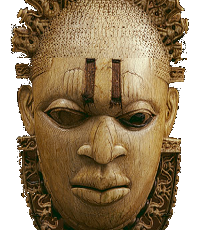The Nile river valley
The Nile is the longest river in the world. It takes the rain that falls in the jungles of tropical Africa northward, passing through eleven countries and the deserts of the Sahara, before it eventually flows into the Mediterranean. Despite the harsh climate, the Nile made it possible to make a living here from the earliest times. Since the water of the Nile periodically flooded the river banks, thereby irrigating and fertilizing the surrounding fields, the valley provided an excellent environment for agriculture. The Nile River valley is one of the first places in the world where human beings took up farming.
It was here that Pharaonic Egypt emerged around 3,000 BCE, quickly growing into one of the mightiest kingdoms of the ancient world. The Pharaohs built pyramids and temples and elaborate irrigation systems; they developed a writing system too, and are famous for their funeral rites, not least for their embalmed mummies. The pyramids at Giza, built in the middle of the third millennium BCE, with their iconic sphinx, were considered by the Greeks as one of the “seven wonders of the world.” Indeed, the Greeks were much impressed with everything Egyptian. This ancient African civilization had a profound influence on the subsequent development of Greek culture.
If we in the days of the Pharaohs had followed the Nile southward we would have arrived in the kingdom of Nubia in today’s Sudan. From ancient times there were important cities here — Dongola, Nabta Playa, Napata, Meroë and others. There are engravings in rocks in the Nubian desert, dating from 5000 BCE, which show cattle, indicating that the people living here were pastoralists, possibly with the cow playing a part in their religious rites. At roughly the same time, the people living at Nabta Playa built stone constructions which may have served as astronomical observatories. It is not clear exactly how they were used, but archeo-astronomers have argued that the stones line up with particular stars. Perhaps they indicated the time of the summer and winter solstice.
Around 3500 BCE the Kingdom of Nubia was established here. The Nubians made money by selling goods from tropical Africa to the Egyptians, gold and ivory in particular. Their culture had much in common with Pharaonic Egypt, but Nubia was an independent kingdom with its own pyramids and system of writing. The Nubians were periodically invaded by the Egyptians who tried to control the lucrative trade, but the Nubians also invaded Egypt. Around one thousand years BCE there was a Pharaonic dynasty run by Nubians. The Nubians were later conquered by the Romans and by the sands of the Saharan desert. Today there are still monumental walls to be seen in their former capitals and the remnants of elaborate irrigation systems with tunnels that transported water deep under the desert.
In Khartoum, the capital of today’s Sudan, the Nile divides into two separate rivers — known as the Blue and the White Nile. The White Nile takes you further south into the jungles of Central Africa and to the source of the river in Lake Victoria. The Blue Nile, on the other hand, takes you into the mountains of Ethiopia. Today Ethiopia is a landlocked country which has suffered badly both from droughts and political instability, but two thousand years ago there was a powerful kingdom here, with Aksum as its capital. The Aksumite Kingdom, 100-940, had close connections with Yemen in the Arabian Peninsula, across the Red Sea. Yemen at the time was dominated by Jewish culture and Jewish culture spread to Ethiopia too. Indeed, Ethiopians insist that the Queen of Sheba came from here.
What is more certain is that the Aksumite Kingdom was heavily involved in trade both with the Arabian peninsula and with the world beyond. The Aksumites were famous exporters of frankincense and myrrh, which together with gold were the presents said to have been given to Jesus after his birth. The Aksumites were trading across the Indian Ocean too. They are referred to as ivory merchants in Periplus of the Erythraean Sea, a Greek merchant’s manual dating from the first century CE. Located at the intersection of these shipping lanes, the Aksumite Kingdom became a major player in the trade which connected India and the Roman Empire. The Aksumite kings minted their own coins in order to facilitate trade, and they erected steles, enormous stone slabs, on which they commemorated their achievements. Many of the steles are preserved to this day.
The Aksumite king converted to Christianity in 325 — after Armenia, in the Caucasus, but a hundred years before the Roman emperors — and from this time onward the symbol of the cross appears on their coins. Today at least half of the population of Ethiopia are Christians. The Ethiopian church follows the Coptic liturgy, first developed in Alexandria in Egypt in the first century CE. Yet links to the Arabian peninsula have remained strong. In the sixteenth century, Ethiopia exported coffee to Yemen from where it was sent on to fashionable coffee shops all over the Ottoman Empire. [Read more: “Coffee and croissants”]
Ethiopia was never colonized by a European power and when the country was invaded by Italy in the 1930s, the emperor, Haile Selassie, made a personal appearance at the League of Nations in Geneva, Switzerland, asking for help. [Read more: “Countries that never were colonized“] This established his reputation worldwide and many black people in the Americas, in particular, were amazed to hear about this African emperor who claimed to be the descendant of King Solomon and the Queen of Sheba. In Jamaica, of all places, Haile Selassie became something of a god in the Rastafari religion practiced by some of the locals.



